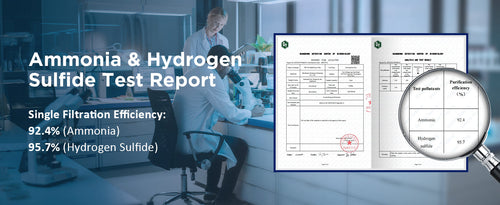Are Air Purifiers a Waste of Money, Effective, or a Scam?
Dust, pet dander, allergens, and other pollutants continuously accumulate in your home, filling it with unpleasant odors, sometimes even worse than outdoor pollution, making you feel extremely uncomfortable. At this point, you notice claims from various brand manufacturers, asserting that their air purifiers can turn your living space into a paradise of fresh, clean air. They all sound too good to be true. So you want to find out: are they real, or are they a scam that exploits people's fears? Is buying an air purifier a waste of money?
Are Air Purifiers a Waste of Money?
Air purifiers are not a waste of money. According to the EPA, air purifiers are an effective way to improve indoor air quality. They can effectively remove 99.97% of 0.3-micron airborne particles and 98.29% of 0.01-micron airborne particles. If you suffer from allergies, or asthma, or are prone to respiratory irritation, investing in air purifiers is worthwhile! (TEST REPORT: MS601 Air Purifier Help With Allergies)
In this article, we will delve into the filtration performance of air purifiers and highlight their most significant strengths to elucidate their real benefits. Additionally, we will discern which purifiers are worth investing in, thereby providing readers with a more informed choice.
How Effective are Air Purifiers in Improving Indoor Air Quality?

Most indoor air purifiers currently utilize a combination of a fan for air intake and multiple filters. Initially, the fan draws air into the filters, and as the air passes through multiple filters, pollutants are captured and intercepted. Eventually, the purifiers release fresh, clean air.
Typically, these air purifiers feature a 3-in-1 or 4-in-1 HEPA filter configuration, consisting of a True H13 HEPA filter, a carbon filter (with antibacterial coating, activated carbon, and charcoal), and a PP pre-filter. They can effectively filter air pollutants ranging from 0.01 micrometers to 0.3 micrometers, with a filtration efficiency of up to 99.97%. Additionally, they can partially alleviate some unpleasant odors, reducing ammonia by 92.4% and hydrogen sulfide by 95.7%.
| Filtration rate of airborne particles | Filtration rate of certain bacteria and viruses | Ammonia & HydrogenSulfide Test Report |
|---|---|---|
| 0.3 microns: 99.97%
0.01 um: 98.29% | H1N1:99.97%
Klebsiella Pneumoniae:99.94% Staphylococcus Aureus: 99.94% | 92.4% (Ammonia)
95.7% (Hydrogen Sulfide) |
Which Pollutants are Most Effectively Targeted by Air Purifiers?
| Pollutant | Filter |
|---|---|
| Pet Hair & Dander Dust | PP electrostatically charged melt-blown filter |
The PP electrostatically charged melt-blown filter creates static electricity in the filter material, increasing the electrostatic adsorption force of air purifiers, and making the filter more effective at capturing and trapping airborne particles.
| Pollutant | Filter |
|---|---|
| Mold Smoke Odors | H13 HEAP filter and 3-in-1 Carbon Filter |
HEPA Filters: Certified to capture 99.97% of 0.3-micron airborne particles and 98.29% of 0.01-micron airborne particles.
HEPA filter With an Activated Carbon filter, it can remove H1N1: 99.97%, Klebsiella pneumoniae: 99.94%, and Staphylococcus Aureus: 99.94% within 1 hour.
| Pollutant | Filter |
|---|---|
| Mold Smoke Odors | H13 HEAP filter and 3-in-1 Carbon Filter |
Antibacterial Coating: Targets Bacteria & Germs,
Activated carbon filter: Eliminates and neutralizes various household odors
Charcoal filter: Absorbs inanimate particulates and dust.
Membrane solutions Air Purifiers Test Report
5 Benefits of Using Air Purifiers
Using air purifiers can significantly improve the freshness and healthiness of the air in your home, bringing about a range of noticeable benefits. Some typical advantages include:
1. Reduced Allergy and Asthma Triggers
Air purifiers equipped with HEPA filters can effectively filter out common triggers for allergies and asthma, such as pollen, dust mites, VOCs/PM2.5, pet dander, and mold. This helps reduce these triggers, aiding in better asthma management and potentially decreasing asthma attacks.
2. Smoke and Odor Removal
Air purifiers with HEPA and activated carbon filters can effectively eliminate smoke and odor, such as pet odor, mold, and smoke, leaving the air fresh. This is particularly important for pet owners, those seeking relief from smoke, and baby care.
3. Reduced Bacteria, Lowered Illness Risk
Air purifiers can effectively reduce the quantity of bacteria and viruses in the air, minimizing their spread and the risk of illness. This is especially beneficial during cold winters when it's challenging to ensure regular air circulation. UV-air filters help reduce airborne viruses.
4. Reduced Cleaning Frequency
By filtering out airborne particles and pollutants like dust mites and PM2.5, air purifiers can decrease the accumulation of dust on indoor surfaces, reducing the need for frequent cleaning. Additionally, they remove indoor odors, such as smoke and kitchen odors, reducing the need to address odors and simplifying household chores.
5. Improved Sleep Qualit
Air purifiers remove allergens and irritants, reducing respiratory discomfort, and making it easier to fall asleep and stay asleep (e.g. if you often experience a stuffy or itchy nose). Additionally, they minimize noise disturbance, providing a quiet sleep environment.
How to Identify the Best and Worst Air Purifiers
- Avoid Air Purifiers without High-Grade HEPA Filters
- Avoid Air Purifiers that Generate Ozone
- Avoid Air Purifiers Unsuitable for Room Size (P-CADR Value)
- Avoid Noisy Air Purifiers
- Avoid Air Purifiers with Single Filtration Systems
- Avoid Air Purifiers with High Maintenance Costs
Conclusion:Are Air Purifiers A Waste of Money?
Overall, investing in 4-stage air purifiers is highly worthwhile. While they are not a one-size-fits-all solution to all indoor air problems, they remain a valuable tool for significantly improving indoor air quality and promoting health. This is especially true for pet lovers, those seeking relief from smoke, baby care, allergies, and asthma.




